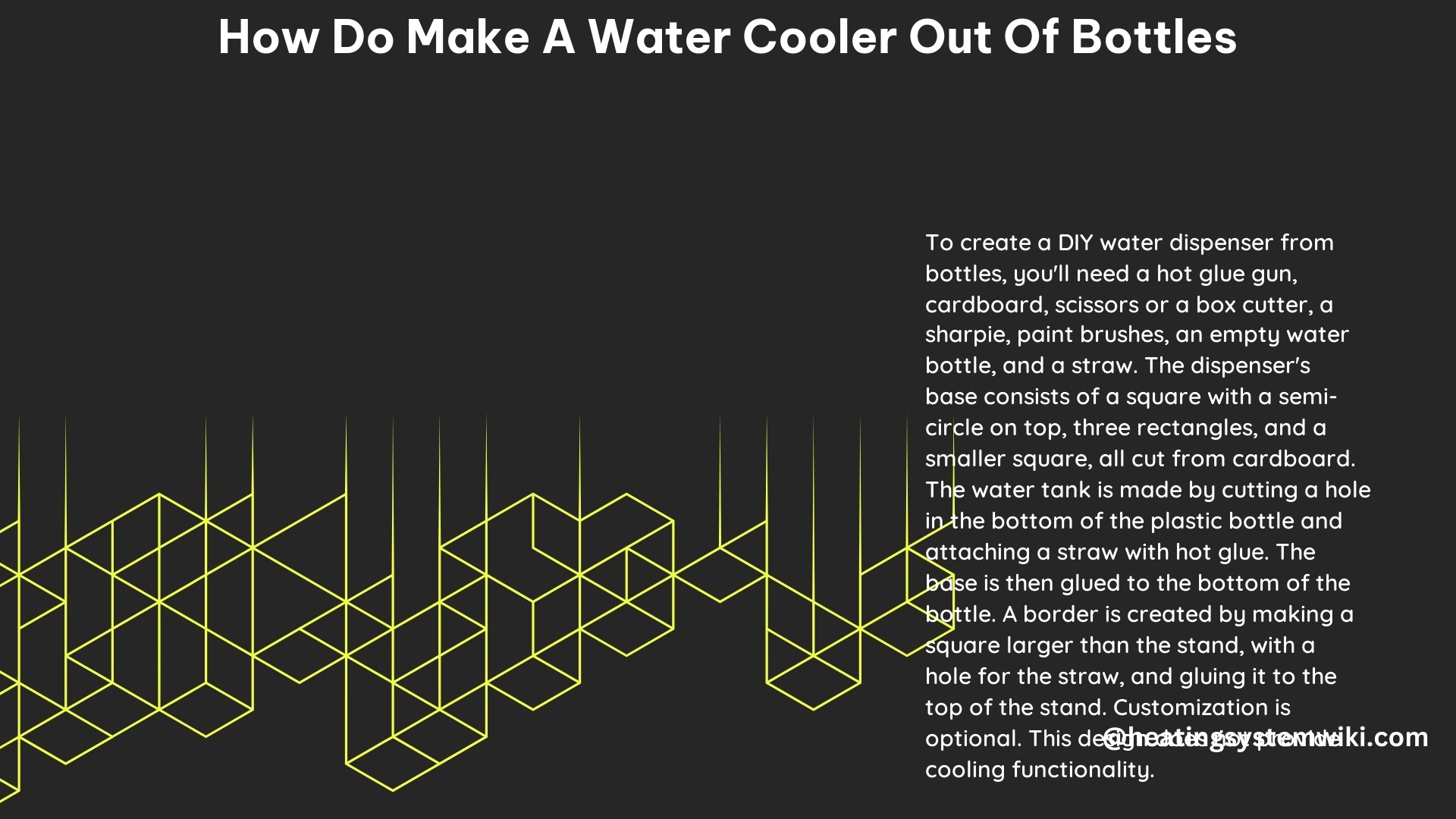Creating a water cooler out of plastic bottles is a cost-effective and eco-friendly DIY project that can provide you with a reliable source of chilled water. This detailed guide will walk you through the technical specifications and step-by-step instructions to build your own water cooler using readily available materials.
Materials Needed
To construct a water cooler out of bottles, you will require the following items:
- Empty Plastic Bottles: 2-liter soda bottles work best for this project due to their sturdy construction and suitable size.
- Drill or Sharp Knife: You will need a tool to create the necessary holes in the bottles.
- Submersible Pump: This small pump will circulate the water through the system. Choose a pump rated for the desired water flow rate.
- Tubing: Food-grade, potable water-safe tubing is required to connect the pump to the bottles.
- Container or Bucket: A sturdy container or bucket will hold the bottles and the pump.
- Ice: Regular ice cubes or blocks will keep the water cool.
Technical Specifications

When selecting the components for your water cooler, it’s essential to consider the following technical specifications:
Submersible Pump
The submersible pump should be rated for the desired water flow rate. For example, if you want to dispense 1 gallon of water per hour, you will need a pump with a minimum rating of 1 gallon per hour.
Some key factors to consider when choosing a submersible pump:
– Flow Rate: Measure the desired water output and select a pump with a suitable flow rate.
– Power Consumption: Ensure the pump’s power consumption matches your available power source.
– Dimensions: Choose a pump that will fit comfortably inside your container or bucket.
– Voltage: Verify the pump’s voltage compatibility with your electrical system.
Tubing
The tubing used to connect the pump to the bottles should be:
– Food-Grade: Ensure the tubing is safe for use with potable water.
– Flexible: Choose a tubing material that can be easily routed and connected to the bottles.
– Durable: Select a tubing type that can withstand the weight and pressure of the water flow.
Container or Bucket
The container or bucket used to hold the bottles and pump should meet the following criteria:
– Capacity: Ensure the container is large enough to accommodate the bottles and pump, with additional space for ice.
– Stability: The container should be sturdy enough to support the weight of the water and bottles.
– Accessibility: Choose a container with a design that allows easy access to the pump and bottles for maintenance and refilling.
Step-by-Step Instructions
Follow these detailed instructions to build your own water cooler out of plastic bottles:
- Clean the Bottles: Thoroughly clean the empty plastic bottles and let them dry completely.
- Create the Water Intake Hole: Using a drill or sharp knife, make a hole in the bottom of one of the bottles. This will be the water intake hole.
- Create the Water Outlet Hole: Make a second hole in the side of the same bottle, near the top. This will be the water outlet hole.
- Insert the Tubing: Insert the tubing into the water intake hole and secure it with hot glue or silicone sealant.
- Place the Intake Bottle: Place the bottle with the water intake hole in the bottom of the container or bucket.
- Add Ice: Fill the container or bucket with ice to keep the water cool.
- Add the Outlet Bottle: Place the second bottle on top of the first bottle, aligning the water outlet hole with the water intake hole of the first bottle.
- Connect the Tubing: Insert the other end of the tubing into the water outlet hole of the second bottle.
- Install the Pump: Place the submersible pump in the container or bucket, ensuring it is fully submerged in water.
- Power the Pump: Connect the pump to a power source and test the water cooler to ensure it is working properly.
Remember to regularly maintain your water cooler by cleaning the bottles, replacing the ice, and checking the pump and tubing for any issues.
Additional Tips and Considerations
- Bottle Size: While 2-liter soda bottles are a common choice, you can experiment with different bottle sizes to suit your needs.
- Bottle Arrangement: The specific arrangement of the bottles can be modified to optimize water flow and cooling efficiency.
- Insulation: Adding insulation around the container or bucket can help maintain the water’s coolness for longer periods.
- Multiple Outlets: You can create additional water outlet holes in the upper bottle to allow for multiple users or fill stations.
- Filtration: Consider adding a water filter to the system for improved water quality.
- Power Source: Ensure the pump is compatible with your available power source, such as a wall outlet or a portable power bank.
By following these detailed instructions and technical specifications, you can create a reliable and cost-effective water cooler using repurposed plastic bottles. Enjoy your homemade water cooler and stay hydrated!
